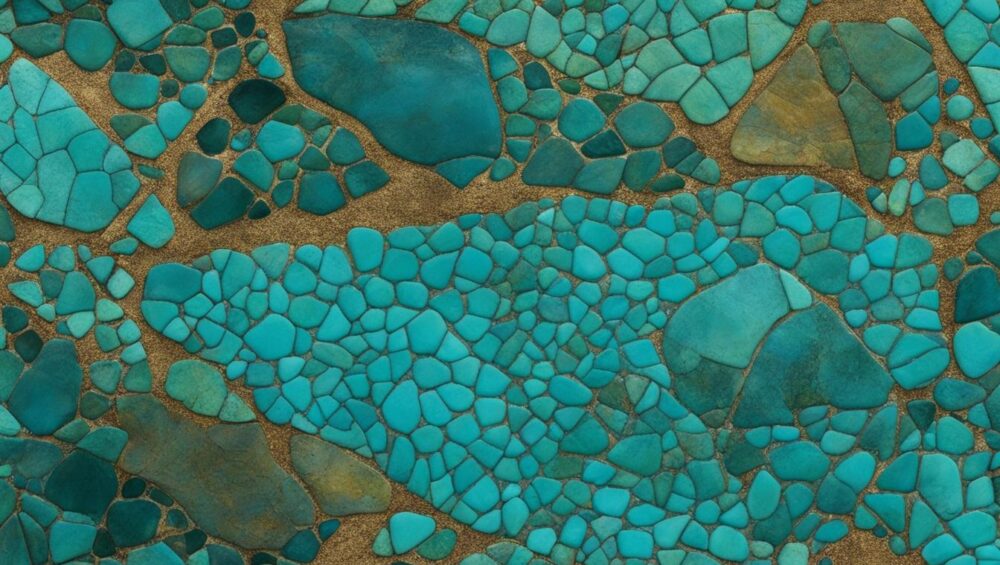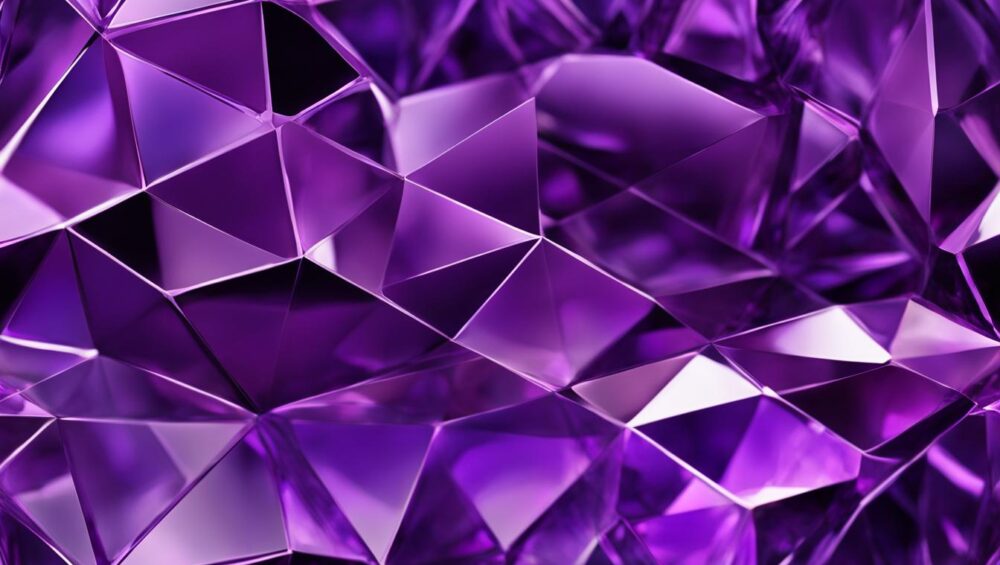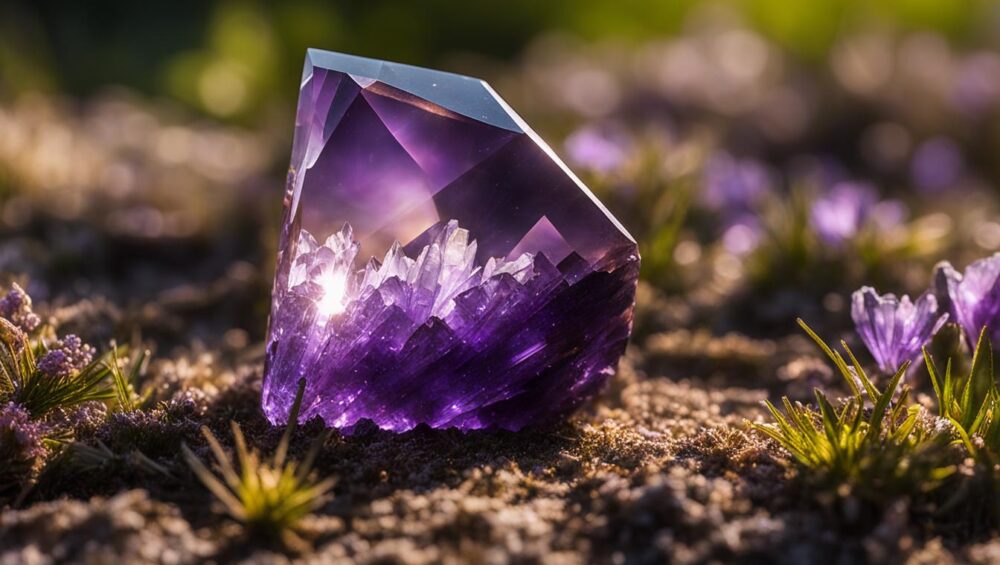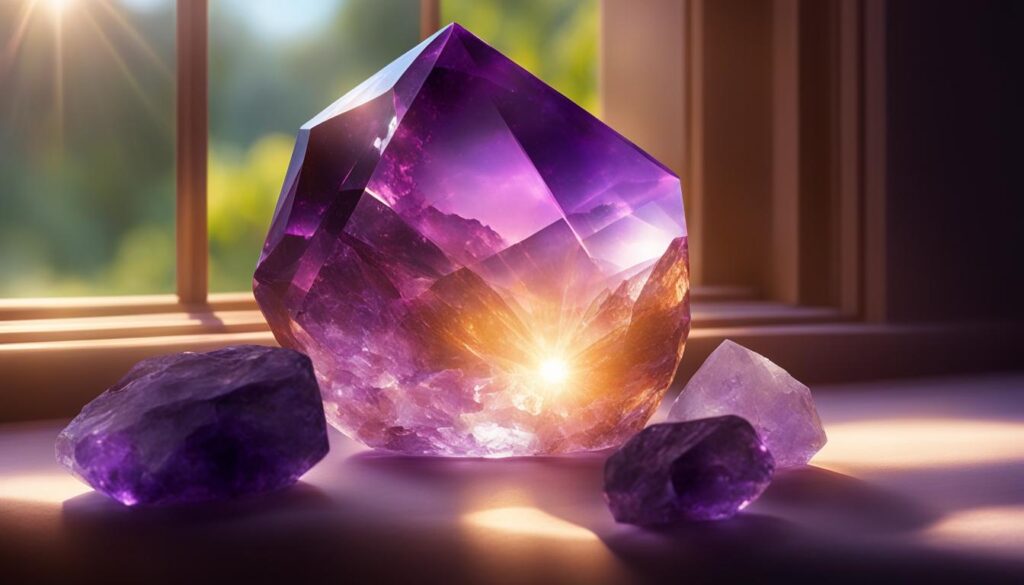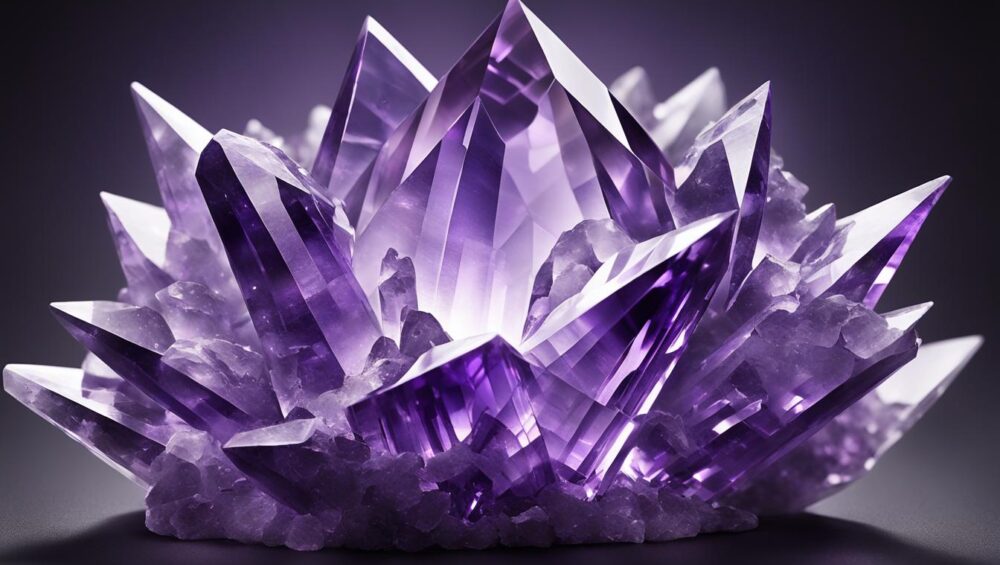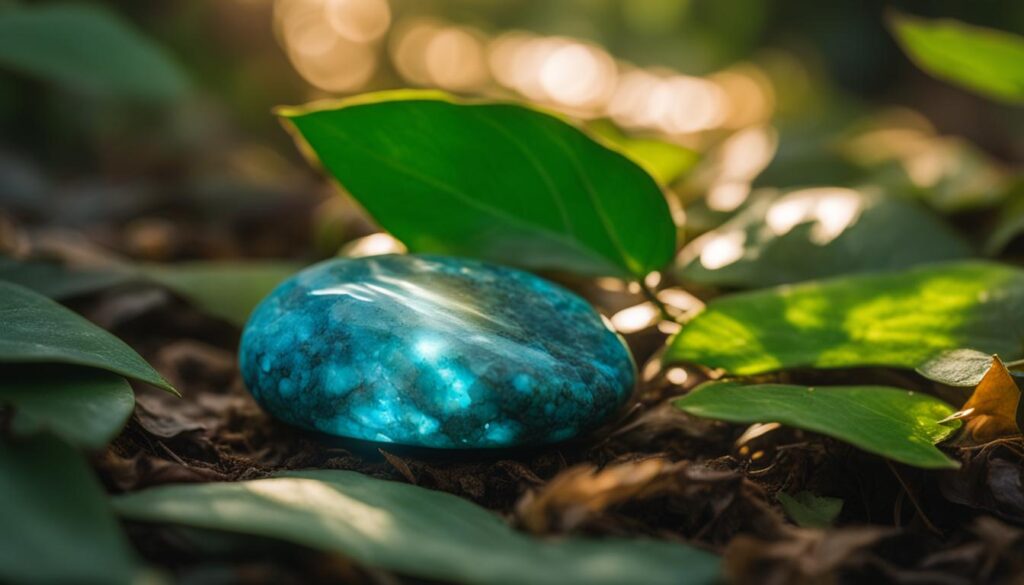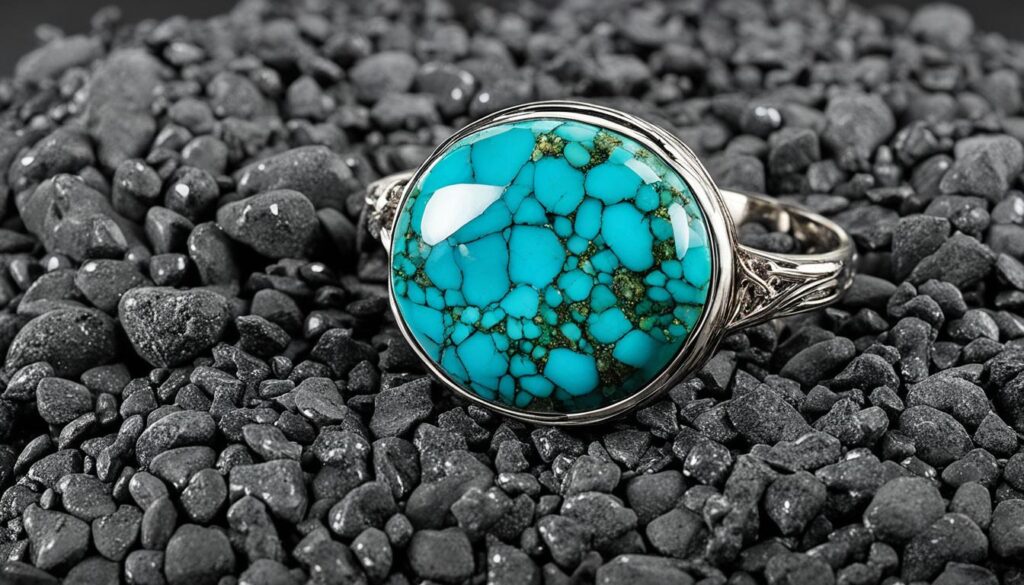Turquoise is a captivating gemstone renowned for its vivid sea-green color. Beyond its vibrant appearance, turquoise holds deep spiritual significance, symbolizing wisdom, protection, and balance. For centuries, this precious stone has been revered in ancient cultures worldwide for its healing and metaphysical properties. In this article, we will delve into the true meaning of turquoise stone, explore its symbolism, discover its role in ancient cultures, and uncover its powerful healing powers.
Key Takeaways:
- Turquoise is a gemstone with a clear sea-green color and holds deep spiritual significance.
- The stone symbolizes wisdom, protection, and balance.
- Turquoise has been revered in ancient cultures and is believed to possess healing and metaphysical properties.
- Ancient cultures, such as Native American, Egyptian, Persian, Greek, and Tibetan, held unique beliefs and myths surrounding turquoise.
- Turquoise stone is associated with symbols of wisdom, tranquility, protection, communication, and forgiveness.
The Roots of Turquoise Stone
Turquoise is a gemstone with a rich history that spans thousands of years. Its captivating beauty and vibrant color have fascinated ancient cultures and civilizations across the globe. Let’s delve into the fascinating history and origins of this remarkable stone.
The history of turquoise stone can be traced back to Medieval Europe, where it was first introduced by Turkish sources. The stone quickly gained popularity and was highly sought after for its unique color and spiritual significance. In fact, the word “turquoise” itself is derived from the French word “turquois,” meaning “Turkish.”
Ancient cultures, such as the Native American, Egyptian, Persian, Greek, and Tibetan cultures, held turquoise stone in high regard. Each culture had its own beliefs and rituals surrounding this precious gem.
Turquoise Stone in Native American Culture
In Native American culture, turquoise held immense symbolism and spiritual meaning. It was believed to represent life-giving waters and was associated with protection, wisdom, and balance. Native Americans believed that wearing turquoise could attract helpful spirits and repel negative energy.
Turquoise Stone in Ancient Civilizations
Ancient Egyptians revered turquoise and used it in their elaborate tombs and jewelry. They viewed the stone as a symbol of heaven and believed it brought protection and good fortune. The Persians also held turquoise in high esteem, associating it with the divine and using it to adorn their ceremonial attire.
Tibetan culture saw turquoise as a sacred stone with great spiritual significance. It was used in religious ceremonies and believed to bring good luck and protection against evil spirits. The Greeks valued turquoise for its beauty and considered it a symbol of victory and success.
“The turquoise is sacred in the religion of the Persian Empire; they adorned their ceremonial attire with this stone because they believed it brought Divine Favor.” – M. J. Meade
The rich history and symbolism of turquoise stone make it an enduring gem that continues to captivate and inspire people to this day.
Next, we will explore the deeper symbolism associated with turquoise stone and its powerful metaphysical and healing properties.
The Symbolism of Turquoise Stone
Turquoise stone holds profound symbolism across various cultures, representing wisdom, protection, and balance. Its vibrant hues and unique energy make it a powerful symbol of spiritual transformation.
Wisdom: Turquoise is universally recognized as a stone of wisdom, promoting self-actualization and unlocking creative energies. It encourages the exploration of one’s inner truth and the pursuit of knowledge.
Tranquility and Calmness: The turquoise stone embodies tranquility and calmness, aiding in the achievement of inner harmony and balance. Its soothing energy helps to alleviate stress, anxiety, and negativity, fostering a sense of peace and tranquility.
Protection and Serenity: Turquoise is often used as a protective talisman, shielding its wearer from negative energy and promoting a sense of serenity. It acts as a spiritual bodyguard, creating a safe space for personal growth and emotional healing.
Communication and Forgiveness: Turquoise is a powerful symbol of open and honest communication. It encourages the expression of thoughts and feelings, promoting clarity and understanding between individuals. Additionally, turquoise facilitates forgiveness and healing of past wounds, allowing for emotional growth and renewal.
Metaphysical and Healing Properties of Turquoise Stone
Turquoise stone is highly regarded for its metaphysical and healing properties. It is believed to possess a strong connection to the throat chakra, making it a powerful tool for enhancing communication and self-expression.
The stone is thought to have a soothing effect on respiratory issues, making it beneficial for alleviating ailments such as sore throats. Its vibrant energy promotes overall well-being and vitality.
Turquoise is also known for its anti-inflammatory properties, which can help boost the immune system and aid in the absorption of essential nutrients. This attribute contributes to its reputation as a healing stone that supports physical health.
Furthermore, turquoise is considered a protective stone, both for the physical body and the spiritual self. It is believed to strengthen the body’s energy field, creating a shield against negative energies and promoting a sense of overall protection.
Moreover, turquoise is associated with psychic abilities, intuition, and spiritual insight. Its serene and calming energy allows individuals to tap into their inner wisdom and gain a deeper understanding of the spiritual realm.
The metaphysical and healing properties of turquoise stone make it a valuable tool for those seeking balance, protection, and holistic well-being.
The Color Meaning of Turquoise Stone
The color of turquoise stone holds deep significance, contributing to its overall meaning and symbolism. Turquoise stone color meaning encompasses various aspects, including tranquility, healing, and balance. The vibrant sea-green color of turquoise evokes feelings of calmness and serenity, much like the vastness of the ocean and the openness of the sky.
Turquoise is a color that combines shades of blue and green, representing the harmonious union of emotions and logic. It is often associated with rejuvenation and renewal, offering a sense of revitalization for the mind, body, and spirit. The soothing properties of turquoise color facilitate clarity and peace, allowing individuals to find inner balance and navigate life’s challenges with ease.
Throughout history, turquoise has been treasured for its calming influence and ability to promote emotional well-being. It has been used in various forms of artistic expression, from ancient artwork to modern-day fashion and décor. The turquoise stone’s distinctive color carries with it a deep sense of spiritual significance and aesthetics.
Turquoise color also holds cultural significance in many societies. It has been associated with healing rituals, spirituality, and protection against negative energies. The brilliant hue of turquoise offers a visual reminder of the interconnectedness of nature and the importance of maintaining harmony within oneself and the world.
The significance of turquoise stone color goes beyond its visual appeal. It represents a multifaceted symbolism that encompasses tranquility, healing, balance, and the fusion of emotions and logic. The color’s timeless allure continues to captivate individuals seeking serenity, inner harmony, and a renewed sense of purpose.
Types of Turquoise Stone
When it comes to turquoise stones, there is an incredible variety to choose from. Each type of turquoise stone has its own unique characteristics and allure. Here are some popular types of turquoise stones:
Carrico Lake Turquoise
Carrico Lake Turquoise is known for its clean, spring-green color. It features a black spiderweb-like matrix, which adds depth and character to the stone. This type of turquoise has a vibrant and refreshing appearance, making it a popular choice among jewelry designers and collectors.
Sleeping Beauty Turquoise
Sleeping Beauty Turquoise is renowned for its rich sky-blue color. It is known for its minimal matrix, giving the stone a smooth and consistent appearance. This type of turquoise is highly sought after for its pure and vibrant hue, making it a favorite among jewelry enthusiasts.
Tibetan Turquoise
Tibetan Turquoise has a distinctive blue-green hue that sets it apart. It is highly valued for its unique color and quality. This type of turquoise is often used in traditional Tibetan jewelry and is treasured for its rarity and beauty.
Number 8 Turquoise
Number 8 Turquoise is known for its vibrant blue color, which can vary with shades of green. It is easily distinguishable by its black, golden-red, and brown matrix, creating a striking contrast. This type of turquoise is cherished for its bold and eye-catching appearance.
Lander Blue Turquoise
Lander Blue Turquoise is a rare and highly coveted type of turquoise stone. It showcases a deep blue color with intricate black spiderwebs and chunks of brown matrices. The unique matrix patterns make Lander Blue Turquoise a truly exceptional and sought-after gem.
Kingman Turquoise
Kingman Turquoise is one of the oldest and most popular types of turquoise. It is known for its sky-blue color and white matrix, which creates a beautiful contrast. Kingman Turquoise is prized for its quality, durability, and classic appearance.
Dragon Skin Turquoise
Dragon Skin Turquoise, also known as Chinese Turquoise, is widely used and admired. It comes in various colors and typically features a dark blue spiderweb matrix. The intricate matrix patterns give Dragon Skin Turquoise a unique and captivating look.
These are just a few examples of the diverse range of turquoise stones available. Each type has its own allure, making turquoise a versatile and beloved gemstone in the world of jewelry and fashion.
Conclusion
Turquoise stone holds deep meaning and symbolism in various cultures, representing wisdom, protection, balance, and tranquility. From ancient civilizations to modern times, this beautiful gemstone has captivated people with its powerful allure and profound spiritual properties.
One of the key healing powers of turquoise stone lies in its ability to enhance communication and self-expression. Wearing turquoise can help you speak your truth with clarity and confidence, facilitating better understanding and connection with others.
Furthermore, turquoise is a stone of forgiveness, enabling emotional healing and encouraging the release of past resentments. Its calming energy promotes a sense of harmony and balance, both within oneself and in relationships with others.
The color of turquoise stone, ranging from serene blues to vibrant greens, adds another dimension of symbolism. It represents serenity, clarity, and openness, inviting a sense of tranquility and peace into one’s life.
As you incorporate turquoise into your life, whether through jewelry, meditation, or simply appreciating its beauty, you invite the healing powers of this stone to unfold. Embrace its wisdom, protection, and balance to experience a greater sense of well-being and harmony in your life.
FAQ
What does turquoise stone mean?
Turquoise stone holds deep spiritual significance, symbolizing wisdom, protection, and balance.
What is the spiritual meaning of turquoise stone?
The spiritual meaning of turquoise stone includes promoting self-actualization, unlocking creative energies, and facilitating communication and forgiveness.
What is the symbolism of turquoise stone?
Turquoise stone symbolizes wisdom, protection, balance, tranquility, communication, and forgiveness.
What are the metaphysical properties of turquoise stone?
Turquoise stone is believed to enhance communication, soothe respiratory issues, boost the immune system, strengthen the body’s energy field, and enhance psychic abilities and spiritual insight.
What are the healing properties of turquoise stone?
Turquoise stone has healing properties that include alleviating respiratory issues, soothing sore throats, reducing inflammation, and promoting overall well-being.
What is the color meaning of turquoise stone?
The clear sea-green color of turquoise stone represents tranquility, healing, openness, and the union of emotions and logic.
What is the significance of turquoise stone color?
The color of turquoise stone brings a sense of serenity, calmness, clarity, and peace to the mind and promotes balance and harmony.
What are the types of turquoise stone?
Some popular types of turquoise stone include Carrico Lake Turquoise, Sleeping Beauty Turquoise, Tibetan Turquoise, Number 8 Turquoise, Lander Blue Turquoise, Kingman Turquoise, and Dragon Skin Turquoise.
What is the significance of turquoise stone in ancient cultures?
Turquoise stone held great significance in various ancient cultures, including Native American, Egyptian, Persian, Greek, and Tibetan cultures, symbolizing life-giving waters, heaven, and attracting helpful spirits and repelling negative energy.
What are the healing powers of turquoise stone?
Turquoise stone possesses powerful healing abilities, promoting overall well-being, enhancing communication and self-expression, and strengthening the body’s energy field.
How can turquoise stone bring harmony and balance?
Incorporating turquoise stone into your life can bring harmony, balance, and a greater sense of well-being by promoting wisdom, protection, balance, tranquility, and communication.
